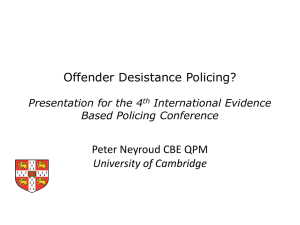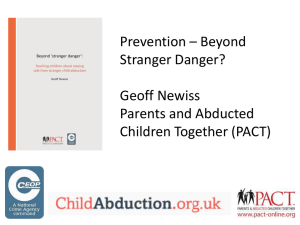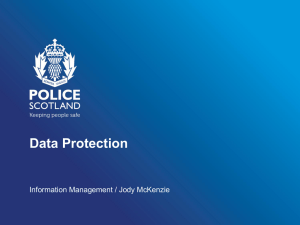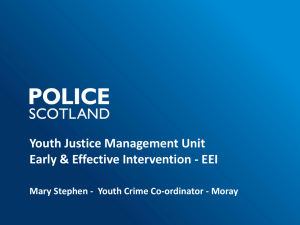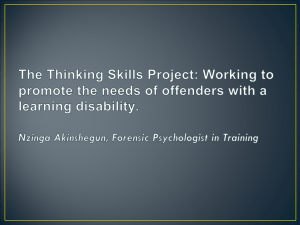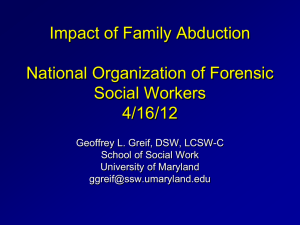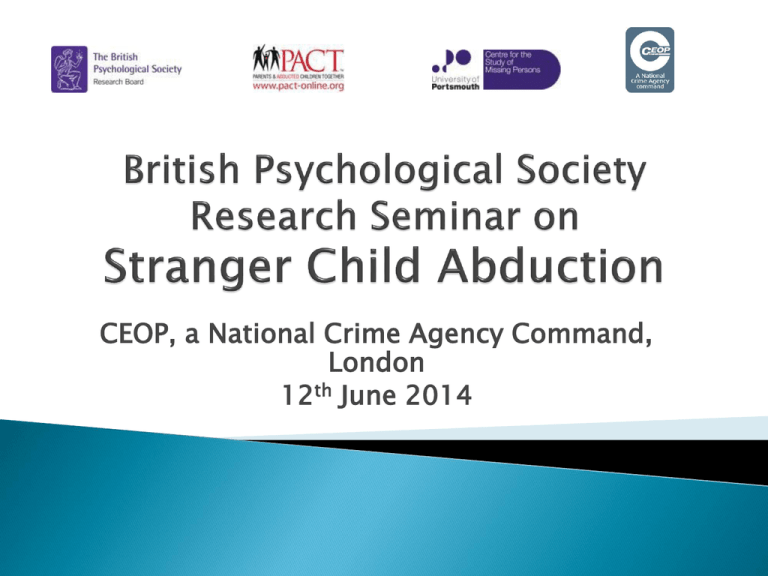
CEOP, a National Crime Agency Command,
London
12th June 2014
Stranger Child Abduction in the UK (Craig Collie,
University of Portsmouth)
Police perspective - investigative challenges and
community impact (Local investigations) (Charlie
Hedges, CEOP)
Police perspective - investigative challenges and
community impact (Child Rescue Alert) (Charlie
Hedges, CEOP)
Offenders - what do we know, what don't we
know (Helen Whittle, Behavioural Analysis Unit,
CEOP)
Prevention – beyond stranger danger? (Geoff
Newiss, PACT)
Where are the gaps in knowledge?
Prevalence
True number of abductions unknown (hidden by recording under other crimes e.g.
rape or murder)
Under-reporting of offences (e.g. why are offences/attempts not reported, how to
encourage reporting)
Drivers of increase/decrease in child abduction
Influence and impact and increased opportunities created by the internet (any
evidence of displacement from offline to online offending?)
The abduction
How to define opportunism? The offender may still have rehearsed and planned the
event even if (s)he hadn’t planned to do it at that particular time
Motivation (differences and implications e.g. gang; maternal; sexual)
Any crossover/overlap with internal trafficking
Attempted abductions (How do they differ to completed abductions? What can we
learn from failed attempts? What are the consequences of attempts for the offender
i.e. what does he/she do next?)
Timescale of the abduction (opportunities to intervene/exploit)
Geography of offences, locations (encounter, attack, release or disposal), distance
travelled to and from offences
◦
◦
Investigators don’t always know the abduction site
A vehicle sighting might be one of the first lines of inquiry
When should attempts be subject to a full and urgent police response?
Differences between kidnap, false imprisonment, abduction, trafficking
The victim
Understanding victimology and what that tells us about the offender
Understanding vulnerabilities of victims ( lack of understanding of risk,
opportunistic, etc) and relationship between vulnerability and opportunity
Particular risk to/vulnerability of children from low SES families and
children with disabilities and mental health issues or those with an
autistic spectrum disorder
Relationship between “missing” and abduction
The offender
Perceptions of threat based on offender characteristics e.g. gender,
relationship to victim
Offenders with no previous criminal record (Is this really their first
offence? How do we find them? What was their journey from thought to
action?)
Characteristics of offenders – who commits these offences and can we
extrapolate any information on the offender from the MO of the
abduction?
Relationship between online and offline offending
Risk assessment of offenders and link to behaviour
Predicting future behaviour
Hidden identities and factors relevant/influencing their release
The investigation and prosecution
When an abduction occurs, investigators might not know
whether it is stranger abduction (or whether it is indeed an
abduction), can research on the early stages of the
offence/investigation identify signs/indicators of what has
happened?
Police response (Overt/covert; intelligence; public/private...)
Outcome of case (e.g. influences)
Prevention and intervention
Prevention and intervention – what works?
How effective has the sex offender register been and what
has been its impact on abductions
Rehabilitation of offenders
Victim support by charities (e.g. good practice; are police
aware of support services available for victims and families?)
Police perspective - investigative challenges
and community impact (local investigations)
Charlie Hedges, CEOP
“Stranger danger” – false perception of prevalence
but you don’t want your child to be that one victim
Media hype
◦ Parents want reassurance
◦ Insurance companies want to include abduction and Child
Sexual Exploitation in their policies
◦ Need a middle ground between inaccuracy of there being
“an offender behind every tree” and the other extreme of
“it’s all hype”
Something in the news somewhere in the UK every
day – we lose the picture in crime reporting
◦ crime statistics report the most significant/serious crime
which occurred in that event (e.g. homicide or rape)
◦ Could examine child murders and sex offences to see how
many start with abduction
◦ Abduction is the MO, a means to an end
Danger in categorising all abductions
together
◦ losing sight of differences
◦ missing more discrete and implicit
behaviours/experiences
◦ E.g. rapists are not a homogenous group and by
putting them all together, there is a danger that
we will miss some of the detail
First challenge - All we know is a child is missing –
we don’t know what has happened (runaway,
abduction etc)
Investigation can’t be channelled/focussed in one
area alone too early on, has to be as broad as
possible and all possible scenarios considered (e.g.
abduction, runaway, accident)
◦ Balance verification and responding quickly
◦ What did the reporter see? Did they misinterpret what they
saw?
What is a stranger? Children can’t always tell the
difference and the lines may be blurred in online
relationships
Police response might depend on whether offender
believes he/she has been seen
◦ Respond in a way the offender would consider appropriate
Language/terminology of first report – can be
difficult to work out exactly what happened
◦ Differences between police, public and media
definitions/understanding of “abduction” and “kidnap”
◦ Reporter’s heightened state of arousal
◦ Age of the reporter (age of victim in attempts too)
◦ Important to have assessment of risk when the call
comes in (as in missing cases), sometimes definitions
get in the way
◦ First responder needs to be trained to elicit the
information (lack of resources in this respect but it is
better now than in the past)
◦ Better to “go high” immediately than “start low and
fight way up”
How many attempts become actual abductions?
◦ How concerned should we be?
◦ We know about motivation for abductions but not in
terms of attempts – is the excitement or thrill of the
attempt enough?
Often police are just not aware of them (not
reported)
◦ Cases not necessarily dealt with effectively
◦ BUT it is difficult to deal with such cases
Need to invest more time
◦ We deal with them a lot but know little about them
◦ Victim doesn’t know what the offender’s intention was
We just DON’T KNOW whether they’re going to
go on to commit a murder
Further guidance and good practice advice required
for practitioners
◦ Difficult – some dislike the idea of “guidance” due to the
risk of constriction of thinking, they want police to use their
discretion and judgement
◦ There is currently no separate authorised professional
practice on abductions – information is included in other
manuals e.g. the Murder Manual
Research concerning attempted abductions to
understand prevalence, motivations and relation to
successful abductions and other forms of offending
Gathering intelligence from partners concerning
attempted abductions (possible role for school
liaison and community support officers)
◦ Consider age of victim – teenagers might be more likely to
tell friends
How can we improve clarity of data?
What are the key challenges?
Context needed in reporting of police stats
Need to be clear about what type of data and
what purpose – e.g. improve data for police
intel and improve data for research
◦ There’s a difference between intel and statistical data
◦ Is it a realistic expectation for police to record all
attempts/unreported events?
Harmonisation of police recording procedures
Prevalence surveys may be subjective (different
perceptions/interpretations – public, police,
children)
Agencies/teams supporting the police don’t
always receive case updates making evaluation
of advice given and operational learning
difficult
Who is involved in Child Rescue Alert cases?
What are the main barriers and obstacles to
working together?
What is needed?
Who is involved?
Police
NCA
Charities
Media (social and traditional)
Public
Questions/challenges:
How often should it be used? Branding vs “CRA fatigue”
How to encourage people to sign up?
Remit - should CRA inform the public and/or receive
information from the public?
What is the most effective way to present information to
maximise the quality and relevance of leads from the public
(e.g. most useful descriptors, best use of language)?
How to make sure you identify the “golden nuggets”?
How much is known from a risk assessment perspective (risk
to child, reaction of offender)?
What is needed?
Clear guidance to avoid duplication
◦ Training and policy in forces
Needs to be used often enough that people feel
comfortable using it but not so often as for it to
lose impact – focussed use
Ability to prioritise information as it comes in
Need to be able to manage the response
◦ E.G. filter messages – did you see the child yourself?
◦ Cannot control the media
◦ More calls received following alert in UK than in other
European countries
Know what NOT to do, to avoid spurring the
offender to harm the victim
Research/greater understanding of false sightings
and how to identify them
How can research translate into practice and
assist in this area?
How can research translate into practice and
improve prevention strategies?
Graduation from non-contact to contact offending
The inter-relationships between physical child
abduction and other types of offending
Is the abductor a different type of person to the “usual”
sex offender?
◦ Assumptions about “type” of offender can derail investigation.
Important that practitioners understand that they are not a
homogeneous group
Role of grooming – pre and post abduction
Offender decision-making
Types of MO
Reoffending patterns
Warning signs/behaviours
Police decision making in focusing investigation
Risk assessment
Any influence/impact/increase in opportunities created
by internet
Prevention and intervention strategies for
offenders and victims
◦ The role/awareness of family members
◦ Computer technology developing at an
alarming pace – training and awareness needed
◦ What factors encourage or discourage
reporting?
◦ Environmental and educational approaches
Treatment of juvenile sex offenders
◦ What is sexually harmful behaviour for children
and young people?
◦ Early interventions and risk assessment
◦ How to encourage parents to seek assistance
for their children?
Research is essential for practitioners but…
There can be misinterpretation and cherrypicking of research findings by practitioners
◦ Academics need to ensure practitioners understand
caveats/limits of findings – emphasise this
Research needs to be written in such a way that
it is easily accessible to practitioners
There is a need to balance how much you say
and what you don’t reveal (so you don’t
educate offenders)
There needs to be more collaboration between
researchers/academics and practitioners
◦ Good practice – contracting/tendering for researchers
to explore practitioner-identified research questions
Prevention – beyond stranger danger?
Geoff Newiss, PACT
www.childabduction.org.uk
Attempted abduction cases are mentioned via social media
all the time even though completed abductions are rare
◦ It is not a “historic” problem as we are sometimes told
How do we help children and young people to understand
the risk from online and real world strangers?
◦
definitional issues e.g. what a child considers a “stranger” or a
“friend”
Need to consider children with learning needs and
disabilities
Behavioural skills training is most effective (Miltenberg &
Olsen, 1996) – practice and rehearse skills
◦ Make children aware of different lures (e.g. sample, authority,
incentive, etc) in broad sense (e.g. don’t have to do everything
that an adult tells you)
◦ The earlier the better. PSHE curricula is not compulsory. Some
schools might do it, others will not
Building self-esteem and confidence in children and young
people is important
Dr. Karen Shalev-Greene, Centre for the Study of
Missing Persons, University of Portsmouth
Email: karen.shalev-greene@port.ac.uk
www.port.ac.uk/departments/academic/icjs/csmp
/
Dr. Llian Alys, Chartered Psychologist and
researcher
(previously - University of Bedfordshire)
Email: Llianalys@yahoo.co.uk


